2014 Lift Truck User Survey: Readers feel optimistic, ready to spend
With plans to buy a total of more than 1,100 lift trucks in coming months, readers share their perspectives on spending, maintenance practices and technology usage.

A common selling point for the adoption of lift truck fleet management practices and technologies is the idea of right-sizing a fleet. The assumption is that most fleets could stand to be as much as 10% smaller once under-utilized equipment has been identified and removed. But another key tenet of fleet management is rotation and retirement, which prevents aging lift trucks from consuming time and money they don’t deserve. Between trimming the fat, deploying state-of-the-art equipment, and riding an increasingly strong economic wave, our readers’ spending plans for lift trucks in the coming year are robust to say the least.
Modern’s annual “Lift Truck User Survey,” conducted by Peerless Research Group (PRG) in June, illustrates several facets of lift truck procurement, operation and maintenance. In recent years, the survey has highlighted trends like the increasing dominance of electric lift trucks, the use of technology to track key metrics, and the growth of leasing and outsourced maintenance plans. But, it has never seen an increase in spending like this. Read the results of last year’s survey.
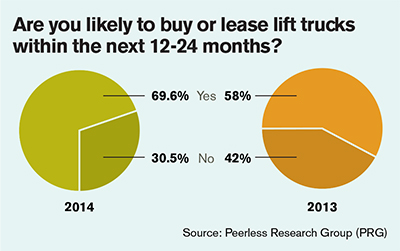
Out with the old, in with the new
Many more respondents (70%) indicate they are likely to buy or lease in the next 12 to 24 months, up from 58% last year. Spending is up across the board from last year, when more than half of those surveyed expected to spend less than $50,000 in the coming year. That number is now down to 46%. Combined with a doubling (7% to 14%) of respondents who expect to spend more than $250,000, the average spend for the coming year has leapt up 26% to $158,000. The median spend also jumped from $33,150 to $58,100.
At the same time, the average annual revenues of respondents’ companies went down 8%, while median revenues dropped from $49 million to $37 million. The respondent base therefore reflects smaller companies that are looking to invest heavily in their fleets.
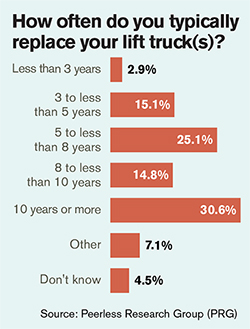
This year, 60% of respondents indicated the economy has little or no impact on how they acquire lift trucks, whereas 19% say the economy influences their decisions to some extent and 21% say the economy impacts their decisions to a great extent. Given their spending plans in the coming months, fleet owners seem quite optimistic.
The average respondent operates a fleet of 24 lift trucks (median: 12) and plans to acquire an additional seven units in the next 24 months. Those who plan an outlay aim to purchase a combined 1,100 lift trucks in that time, with a quarter planning to buy between five and 19 units. About 9% will buy more than 20 trucks and 68% will buy four or fewer. Of new units purchased, two-thirds will replace old equipment, while the remainder will add to the total size of the fleet.

Maintaining productivity
In a series of new questions this year, we asked readers whether or not they operate a “core” fleet of regularly used lift trucks in addition to a less-utilized reserve fleet. About 42% of respondents take this approach. For those who buy their lift trucks outright, 30% report the dealer takes an older unit when they drop off a new one. Another 20% hold on to old lift trucks even after they are replaced just in case they are needed, and 17% keep redundant units for parts. More than 50% resell the lift trucks that are replaced.
The number of respondents who typically lease lift trucks ticked up a bit, as they noted benefits like access to more current technology and improved cash flow. But the sentiments of those who typically buy outright have shifted. Last year, 37% of those who typically buy said they do so because it is cheaper. Now, only 24% believe that to be true.

Like last year, the same 41% have adopted, or plan to adopt, technology to help manage the fleet. However, in every category of metrics tracked (except labor management), more respondents are using the technology to manage things like maintenance history (86%), the cost to maintain (75%), and safety (65%) including impacts and injuries. At the same time, satisfaction with fleet management programs has waned, with more than one in 10 reporting their implementation has been “not very” or “not at all” successful, nearly double since last year.

Flexing their buying power
We asked respondents how likely they are to evaluate lift truck manufacturers whose lift trucks they are not currently using when adding new lift trucks to their fleet. Last year, 16% of respondents said they were “very unlikely” or “not at all likely” to consider new suppliers, and that number has increased to 23%, indicating an increase in brand loyalty.
That said, respondents are certainly not becoming complacent when it comes to finding the right supplier. The number of respondents who work with a “short list” of approved vendors has increased from 36% last year to 53% this year. But the number of respondents who have had cause to remove a vendor from that short list is up from 17.5% to 28%. Poor service or product quality was by far the most commonly cited reason for the removal, with some respondents noting “chronic overcharging” and one who suggested the service provider was “unable to migrate from simply selling equipment to helping manage the fleet.”
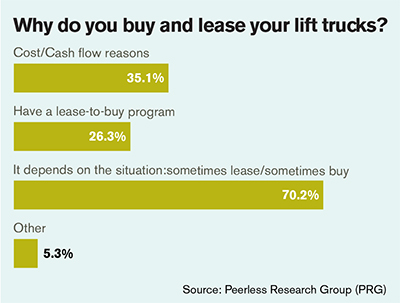
Who responded to our survey?
Peerless Research Group (PRG)received a total of 310 qualified responses to this year’s survey. A qualified response was defined as an individual who was personally involved in the evaluation, selection and/or procurement of lift trucks for their facility.
Respondents represented a broad range of manufacturing and distribution verticals, including food, beverage and tobacco (12%); general manufacturing (12%); wholesale trade/other non-manufacturing (11%); fabricated metals (10%); and automotive (8%).
Respondents were equally divided between manufacturing facilities (46%) and warehouses and distribution centers (45%). The average facility employed 152 people.
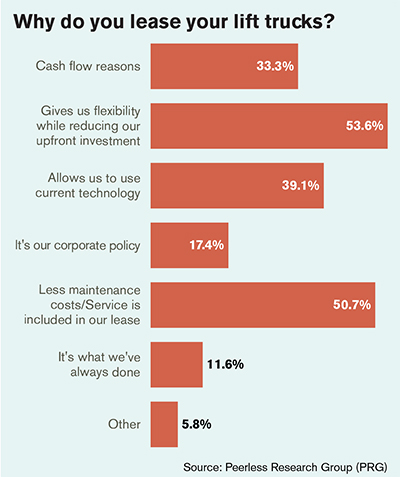
Slightly more than half of respondents work at companies with less than $50 million in annual revenue; however, nearly 18% worked at facilities with more than $1 billion in revenue, including 9% at facilities with $5 billion or more. The average annual revenue is $795 million, with a median of $37 million.
Nearly 46% of the respondents planned to spend less than $50,000 in 2013 on lift trucks; however, 6% expected to spend more than $500,000 and another 7% plan to spend between $250,000 and $499,999 in 2013.
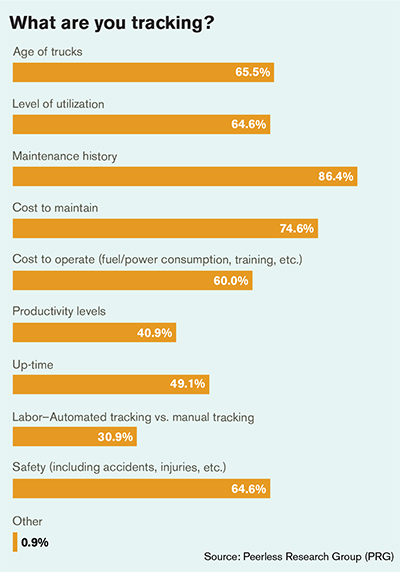

Article Topics
Latest in Logistics
LM Podcast Series: Assessing the freight transportation and logistics markets with Tom Nightingale, AFS Logistics Investor expectations continue to influence supply chain decision-making The Next Big Steps in Supply Chain Digitalization Under-21 driver pilot program a bust with fleets as FMCSA seeks changes Diesel back over $4 a gallon; Mideast tensions, other worries cited Four U.S. railroads file challenges against FRA’s two-person crew mandate, says report XPO opens up three new services acquired through auction of Yellow’s properties and assets More LogisticsAbout the Author
Subscribe to Logistics Management Magazine

Find out what the world's most innovative companies are doing to improve productivity in their plants and distribution centers.
Start your FREE subscription today.
April 2023 Logistics Management

Latest Resources














